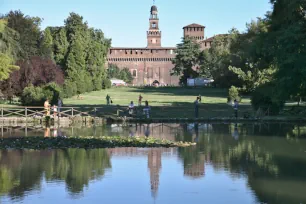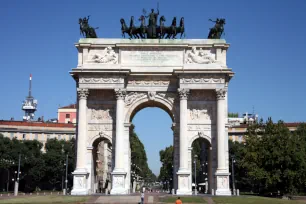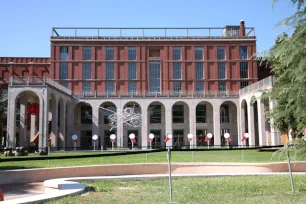Parco Sempione is a forty-seven hectare (116 acres) large park near the Sforzesco Castle, just outside the historic center of Milan. There are a number of noteworthy buildings and monuments in the park, such as a large triumphal arch and a more than one hundred meter-tall tower.


The park is nicely laid out in a landscape style with winding paths, open grassy areas, tall trees and a picturesque bridge across a central pond. It is especially popular during spring and summer, when many events are held in the Sempione Park.
Hunting Ground
The park’s origins go back to the fourteenth century, when the Visconti ruled over Milan. They used the land behind their castle as a hunting ground, which was later expanded to an area of about three hundred hectares.
The last of the Visconti, Filippo Maria, was the first to create a garden behind the castle in the early fifteenth century.
The garden was neglected during the era of foreign occupation of Milan and in the early 1800s Napoleon envisaged a grand plan, known as the Foro Bonaparte, which would turn the terrain behind the Sforzesco Castle in a military parade ground stretching from the castle to a monumental victory arch. Due to Napoleon’s downfall in 1815 the plan was abandoned, with the arch and a historic arena as its only legacy.
The present-day park was created between 1890 and 1893, when it was laid out in the then popular English landscape style by local architect Emilio Alemagna.
Buildings and Monuments



Alemagna incorporated several structures that were erected for Napoleon’s planned Foro Bonaparte: the Arena Civica, the Arco della Pace and the nearby custom houses.
The Arena Civica, located in the eastern part of the park, was built in 1806 after a design by Luigi Canonica who was inspired by the classical arenas of Ancient Rome. Napoleon himself attended the opening of the arena, which was used for a wide range of activities such as festivities, horse races and even Roman-inspired chariot races. Later the arena also hosted football games, athletics events and concerts. It is still in use today.
Another legacy of Napoleon is the Arco della Pace, which was originally built in 1807 by Luigi Cagnola as the Victory Arch, but when the monument was finally completed in 1838, Napoleon had long dropped out of the picture and the arch was inaugurated as the Arco della Pace (Peace Arch) by King Ferdinand I of Austria.
Just south of the Arena Civica is the Acquario Civico, the only remaining structure of the 1906 Milan World expo. The aquarium was designed by Sebastiano Locati in Stile Liberty, a local version of the Art Nouveau style. The front facade is decorated with colorful tiles, a central statue of Neptune and several sculptures of sea animals.
Another interesting structure in the park is the Torre Branca, a 108-meter-tall (354 ft.) tower erected in 1933. It is located in the western part of the park. A platform, situated at a height of 97 meters, gives visitors a great view over the Sempione Park, the Sforzesco Castle and even the historic center of Milan. Near the tower is the Palazzo dell’Arte, which was built that same year as the permanent location of the Triennial Exposition of decorative art.
- Next: Sant'Ambrogio
- More Sights & Attractions in Milan

